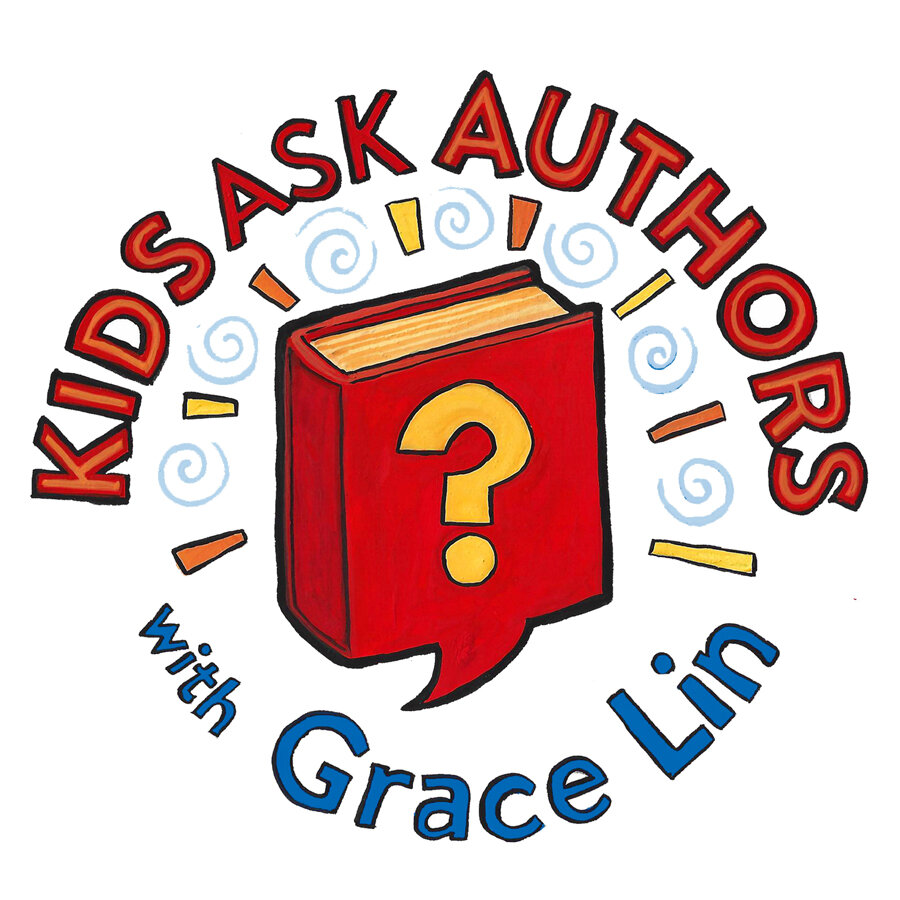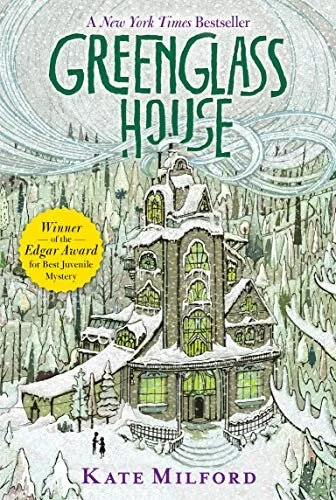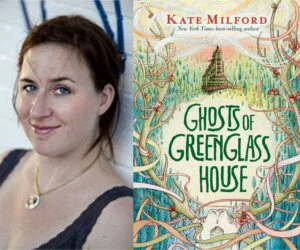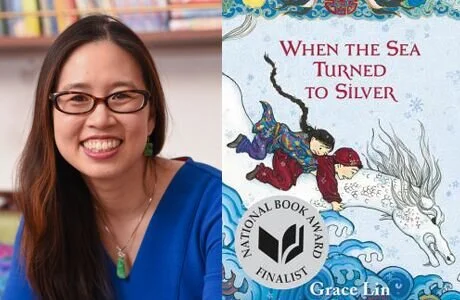Episode# 94: How do you brainstorm your plots? with Kate Milford
Welcome! Today on the Kids Ask Authors podcast, Grace Lin and Kate Milford answer the kid question: “How do you brainstorm your plots?” Thanks for joining us!
TRANSCRIPT:
Grace Lin: Hello. I'm Grace Lin, children's book author and illustrator of many books, including the middle grade novel When the Sea Turned to Silver and the picture book A Big Mooncake for Little Star. Today, I am here with Kate Milford, the author of middle grade novels such as the Greenglass House and The Raconteur's Commonplace Book. Hi, Kate.
Kate Milford: Hi.
Grace Lin: Thanks so much for joining us today.
Kate Milford: Thank you for having me. This is great.
Grace Lin: Are you ready for today's kid question?
Kate Milford: Yes.
Grace Lin: Okay. Today's kid question is from a kid named Piper. And Piper asks...
Piper: How do you brainstorm your plots?
Grace Lin: How do you brainstorm your plots?
Kate Milford: Oh, Piper, that's such a good question. I do, it sort of depends for different books. Sometimes if I am asked to really plan it out for various reasons, I will sit down and try and write a little bit of an outline. But I'm not really very good at it and I don't like to write outlines. So most often, I sit down and I start writing the scene that I am most excited about, the scenes that made me want to write this book in the first place. And then I start filling in the gaps. And so I know a few things about the story that are going to happen and I start working toward those things.
Kate Milford: And I work from scene that I know to scene that I know. And inevitably, somewhere along the way, I realize there's something I don't know, whether it's that I don't know enough about a character or I don't know enough about what the motives for the mystery that I'm writing or there's something I don't know. And so that's the point when I kind of stop and I think, huh, maybe I should have done some more planning. And then I sit down and I figure out what thing is missing that I don't know. And sometimes that means going back to do some more research. Sometimes that means writing a few new scenes to get to know characters better, even if those scenes might not make it into the book. And sometimes it means really thinking about the ending and working backward from there.
Kate Milford: So I use a lot of different techniques, but the main thing is I usually start with a few things that I'm really excited about, stuff that I know I want to be in this book, some scenes that I know I want to happen, and I go from there.
Grace Lin: So you kind of brainstorm after you're halfway done.
Kate Milford: Yeah, at various times along the way. And sometimes, because sometimes I don't know what thing is missing until I hit the place in the story where it's obvious that something is missing. And that usually for me looks like writer's block. If I hit writer's block or have anything that's I'm sitting there, I'm like, man, I'm just not getting anything done, usually that means I've hit the point where there's something I don't know. And that's when I have to sit down and start figuring out my way through that.
Grace Lin: That's so interesting. You know, I do a little bit similar because I too, I'll write part of it and then I'll realize, oh, I have to rethink this or I have to brainstorm...
Kate Milford: Mm-hmm (affirmative).
Grace Lin: ... some more ideas. That happens to me a lot. But you said that you write a couple of scenes first or you know the couple of scenes first, the ones that you're excited about. Do those tend to be end scenes?
Kate Milford: No, they're usually not. I sort of notoriously don't know how a book is going to end when I start it. I have heard a lot of writers say they can sort of work their way through as long as they know where they're going. And I sadly, usually don't know where I'm going. But this kind of also, if you think of it like a metaphor of a road trip, sometimes even my road trips I don't really know where I'm going. I just want to sort of see what's out there, I want to see what looks interesting, and I want to see what captures my interest.
Kate Milford: And sometimes because of that, the story will change a lot while I'm writing it. I might change my mind about who the antagonist is. I might change my mind about when it's set. I might change my mind about locations. And I really like that actually. I think that would, I know that would drive a lot of people nuts and a lot of writers I know really like to plan. But for me, I really like to sort of find my way and have some chances to be surprised along the way.
Grace Lin: Well, I'm a little similar, but I think I'm more one of those planners because I know that for me I can only start writing when I know the end scene. I need to know the end and then I can start, right?
Kate Milford: Yeah.
Grace Lin: I usually know the scene at the very end and I probably know probably one, maybe two scenes in the middle. And then I'm always kind of trying to work towards those scenes...
Kate Milford: Yeah.
Grace Lin: ... like you said. But I definitely need to know the end before I can go. So that's where we're different.
Kate Milford: Yeah. It's kind of like there is such a good... That road trip metaphor I think really makes a lot of sense in some ways because it's sometimes you can set out and you're like I don't know how long this trip is going to be, but I know I want to make sure to see the Grand Canyon and I want to make sure to stop at this particular restaurant that I've read about. And so those are your landmarks, your spots along the way, you know you're working toward those. And then you might find something interesting. In between those, you might decide to change your course, but you know you're going to come back because you don't want to miss the Grand Canyon or whatever.
Grace Lin: Yeah. Exactly. So before I start a novel, I usually go get a bunch of post-it notes and I write down the little scenes that I've been seeing in my head, and I put them on a board and I'm like, okay, these are the scenes and try to lay it out. So those are the landmarks and the hopes that I can...
Kate Milford: Yeah.
Grace Lin: ... hit these landmarks while I'm trying to ride to the end. But sometimes there's a lot of landmarks that I miss. And like you said, there's other landmarks that you're...
Kate Milford: Yeah.
Grace Lin: ... pleasantly surprised by. Do you do something like that too? Do you do post-it notes in the beginning or anything like that?
Kate Milford: I keep a notebook for every project that I think I want to write. So as soon as I have enough of an idea about a project that I think this might be something that'll come together into a story that I want to spend some time with, then I start sort of collecting notes in that notebook. And sometimes those notes are things that I've come across in research where it's like I know that I want to use this for something. And then it starts to make sense with something else that I've been thinking about. Sometimes I might know just enough about a story to know the kind of thing I need to research. So with Bluecrowne and The Left-Handed Fate, I knew that I needed to know about nautical life in right around the War of 1812. So then I start reading things about that era and then I'll find things, find those interesting things that I know I might want to use or that might help to inform a character and I start making those notes.
Kate Milford: And so I tend to, for me it's notes about characters and notes about the world and notes about the history that caused this particular moment to happen. Those tend to be my notes. And weirdly, and sometimes it's things like, well, I don't know where I'm going to use this, but I know I want to use the thing about this particular piece of nautical lore, but I don't know where it's going to go in the story. And then when I figure out the scene where that thing is going to go, that might become one of the scenes that I start in to write or one of those things that I know I'm working toward. But my notes don't tend to be about the scenes and the moments. It tends to be about the characters and the world.
Grace Lin: Yeah. Yeah. I do run into that sometimes too because I read a lot of Chinese folktales and lots of backgrounds and histories, and I'll be like, oh, I want to put this in so...
Kate Milford: Yeah.
Grace Lin: ... badly.
Kate Milford: Exactly. So then you also...
Grace Lin: But sometimes it just doesn't fit, which is so sad.
Kate Milford: Yeah. Well, so then you need a place to keep all of those notes and those pieces where you don't know what they're going to belong to, but you know you don't want to lose them. And so that's another thing. I try to make sure that I have a place to keep the ideas that are so good and I don't know what they belong to, but I know I want to use them eventually. So I have a ton of notebooks that are just that kind of thing.
Grace Lin: Yeah, me too. I have a whole drawer of notebooks like that.
Kate Milford: Yes. And so then sometimes when you hit that point where it's like, huh, I'm feeling a little writer's blocky right now, which again for me is usually there's something I don't know, there's a piece missing, then I can go into those notebooks. I can dive into that particular collection of things and find, hopefully find something that looks like a piece that might fit.
Grace Lin: Awesome. Well, thank you so much for answering Piper's question today, Kate. And thank you Piper for asking such a great one.
Kate Milford: Thank you so much, Piper. That's such a good question. And if you ask me after the next book I write, I probably will have a different answer for you.
Grace Lin: All right. Thanks so much, Kate. Bye.
Kate Milford: Thanks, Grace. Bye.
Today’s BOOK REVIEW comes from Zahabia! Zahabia is reviewing, Greenglass House by Kate Milford.
Hi, my name is Zahabia and the book I would like to talk about is the Greenglass House by Kate Milford.
Greenglass House is about a boy named Milo, who lives in an inn his adopted parents own. The inn has a long, rich history. It used to be a famous smugglers house, Doc Holystone to be exact. Soon mysterious guests fill up the house, and they all seem to be searching for something.They are thefts to be solved and a greater mystery too. Milo and his friend Meddy, their chef’s daughter rush to solve the mystery in time, before things go South. But is Meddy hiding something too?
This book is so captivating and has so many twists and turns! I couldn’t put it down! It has great attention to detail. It also talks about how Milo was adopted and how he feels about that. Also, this book won the Edgar award for juvenile mystery. If you like mystery books then I would recommend this book to you. ~ Zahabia Shahpurwala
Thank you Zahabia!
About today’s authors:
Kate Milford is the New York Times bestselling author of Greenglass House (winner of the Edgar award for juvenile literature, long-listed for the National Book Award for Young People’s Literature, and a nominee for the Andre Norton Award and the Agatha Award for Children’s/YA) as well as its sequel, Ghosts of Greenglass House, and five other books set in the same world: The Boneshaker, The Broken Lands, The Left-Handed Fate, the crowdfunded companion book, The Kairos Mechanism, and her newest release, Bluecrowne, which also began life on Kickstarter but has been reissued in a newly expanded hardcover version from Houghton Mifflin Harcourt.
Kate has written for stage and screen, and as a contributing writer at nagspeake.com she has authored scholarly articles on subjects as varied as self-aware ironmongery and how to make saltwater taffy in a haunted kitchen. Kate grew up in Riva, Maryland, and now lives in Brooklyn, New York with her husband, two children, and their dog.
Grace Lin, a NY Times bestselling author/ illustrator, won the Newbery Honor for Where the Mountain Meets the Moon and her picture book, A Big Mooncake for Little Star, was awarded the Caldecott Honor. Grace is an occasional commentator for New England Public Radio , a video essayist for PBS NewsHour (here & here), and the speaker of the popular TEDx talk, The Windows and Mirrors of Your Child’s Bookshelf. She is the co-host of the podcast Book Friends Forever, a kidlit podcast about friendship and publishing (geared for adults). Find her facebook, instagram , twitter ( @pacylin) or sign up for her author newsletter HERE.
Thank you so much for tuning into to Kids Ask Authors! We would appreciate your continued support on our Patreon page! Please consider becoming a member for all kinds of exclusive perks. https://www.patreon.com/kidasaskauthorspodcast
Join the Book Reviewer Club here! : https://www.kidsaskauthors.com/join-the-kid-reviewer-club
Order the 2022 WTMMTM CALENDAR: https://shop.carlemuseum.org/category/books/autographed-books/grace-lin
Sign up for Grace's author newsletter: https://lp.constantcontactpages.com/su/kEmJMT3/newsletter



